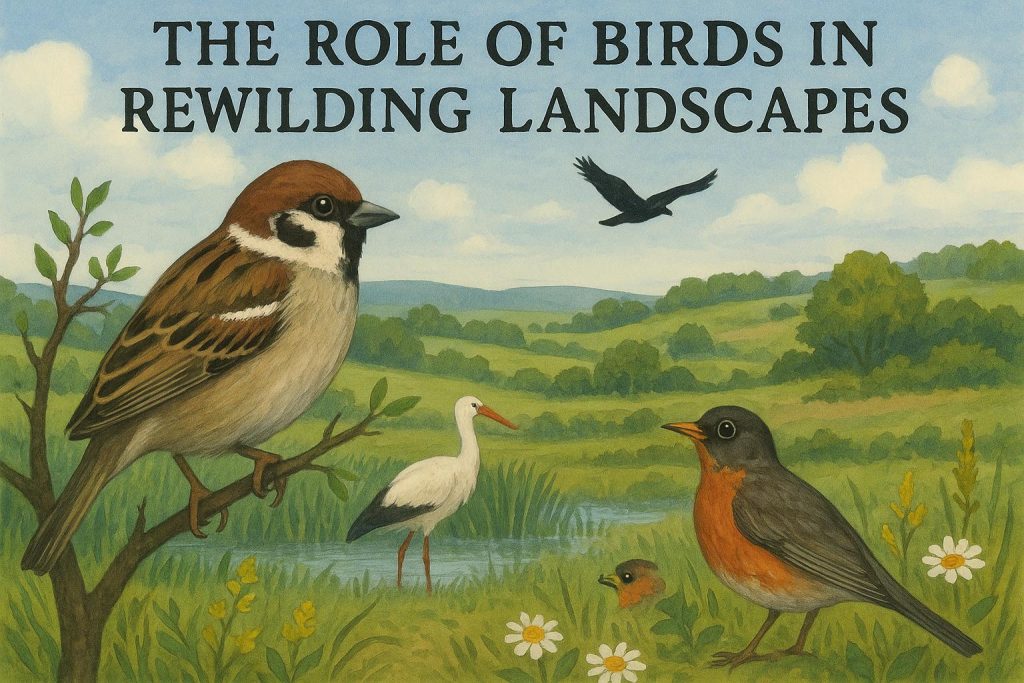
The Role of Birds in Rewildering Landscapes
The Role of Birds in Rewildering Landscapes
In recent years, the practice of **rewildering** has become increasingly recognized as an effective strategy for the restoration of natural ecosystems and the promotion of biodiversity conservation. Essentially, rewildering involves restoring environments to their natural, uncultivated states by reintroducing native flora and fauna, encouraging natural processes, and minimizing human interventions to foster a balanced ecosystem. Within this framework, birds have emerged as pivotal contributors due to their unique ecological roles and the benefits they offer to rewilding efforts.
Birds as Seed Dispersers
A critical function that birds offer in the context of rewildering is their role as seed dispersers. Numerous bird species consume fruits and seeds, which after digestion are expelled in various locations through their droppings. This natural seed dispersal mechanism is instrumental in promoting plant growth in new areas. It facilitates the expansion of plant species into locations they might not have reached otherwise. Not only does this process contribute to the proliferation of individual plant species, but it also enhances the overall diversification of plant communities within an ecosystem. Such diversified plant communities form the backbone of a heterogeneous landscape that supports a more extensive range of wildlife, contributing to healthier, more robust ecosystems.
Birds as Pollinators
While insects like bees commonly receive recognition for their pollination activities, many bird species also play vital roles as pollinators, particularly in ecosystems where they act as primary agents for this ecological service. Species such as hummingbirds, sunbirds, and certain types of parrots engage in pollination by feeding on the nectar of flowers. As they move from one blossom to another, they inadvertently transfer pollen, thereby enabling plant reproduction and ensuring a mosaic of genetic diversity. This biodiversity is essential for the adaptability and survival of plant species, which ultimately supports a more resilient ecosystem.
Birds in Predation and Pest Control
Apart from their roles in seed dispersal and pollination, birds contribute to ecosystem dynamics through predation and pest control. Predatory birds, such as hawks and owls, are crucial in maintaining the balance of rodent populations. Their hunting activities prevent rodent numbers from reaching levels that could be detrimental to the ecosystem. Similarly, smaller avian species naturally manage insect populations by feeding on various insect pests. This natural form of pest control is invaluable, as it mitigates the need for human-made pesticides, which often carry negative environmental impacts. Through these predatory and pest-controlling roles, birds help sustain the delicate equilibrium of food webs within ecosystems.
Birds as Ecosystem Indicators
Birds also serve as essential **indicators** of ecosystem health. Their presence, behaviors, and population trends can reflect broader environmental conditions. Alterations in these factors can signal changes in climate patterns, pollution levels, or the viability of habitats. By monitoring bird populations, researchers and conservationists gain insightful data on the status of environmental health. These observations help in recalibrating and optimizing rewildering strategies to address emerging ecological challenges effectively. The information gleaned from bird population dynamics ensures that restoration efforts remain on course and are adapted to sustain resilient environments.
Integrating Birds into Rewildering Strategies
Given the multiple roles that birds play within ecosystems, their integration into rewilding initiatives becomes not just beneficial but necessary. Understanding and harnessing their contributions can redefine restoration approaches to be more inclusive and holistic. By emphasizing the natural behaviors of birds, such as seed dispersal, pollination, and predation, ecologists can create conditions that naturally facilitate the restoration processes they aim to achieve. By focusing on avian biodiversity, conservationists can enhance landscape resilience and encourage regenerative outcomes across various ecosystems.
Challenges and Considerations
While the benefits of including birds in rewildering strategies are manifold, several challenges must be acknowledged. Factors such as habitat loss, climate change, and anthropogenic disturbances pose significant threats to bird populations. Mitigating these threats requires comprehensive strategies that include habitat protection, climate action, and the reduction of human-induced impacts. Additionally, ensuring that landscapes remain conducive to avian life involves creating habitat corridors, providing adequate food resources, and safeguarding nesting sites. These considerations must remain at the forefront of effective rewilding strategies.
Advancing Rewildering Efforts
To maximize the effectiveness of rewildering efforts, continued research and collaboration between interdisciplinary stakeholders are essential. Conservationists, ecologists, policymakers, and local communities need to work synergistically to establish rewildering initiatives that consider the multifaceted roles of birds. Education and awareness campaigns can foster community support and engagement, creating value in efforts to restore natural landscapes. Additionally, implementing sustainable adaptive management practices can refine rewildering strategies over time, ensuring that they remain relevant and responsive to environmental changes.
Conclusion
Within the expansive domain of ecological restoration, birds emerge as indispensable allies. Their vital roles in seed dispersal, pollination, predation, and as indicators of environmental health underscore their significance in rewilding landscapes successfully. As conservationists and ecologists progress in developing and implementing rewildering initiatives, the integration of avian dynamics must remain a critical component of achieving sustainable outcomes. In acknowledging and leveraging the ecological functions that birds provide, we can advance towards restoring ecosystems that are robustly diverse and vibrantly viable.